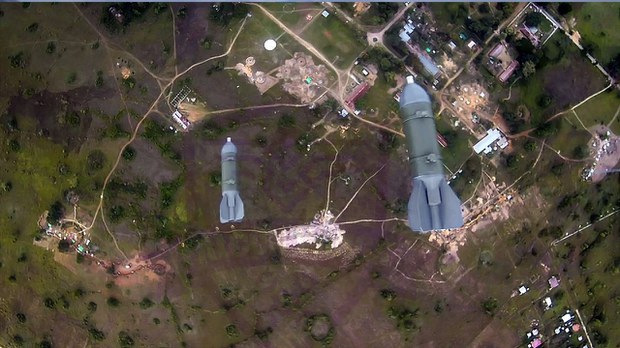Two years into Myanmar’s civil conflict, civilian drones refitted to drop explosives on junta troops are helping turn the tide against the country’s better-equipped military, rebel groups say.
Drones were once used exclusively by the army to detect and crack down on pro-democracy protests on the streets of Myanmar’s largest city of Yangon in the days after the Feb. 1, 2021, takeover.
When the anti-junta People’s Defense Force first formed in the months following the coup, its members were forced to fight Southeast Asia’s second-largest army using only slingshots and the same crude flintlock “Tumee” rifles their forefathers used to fight British colonizers in the 1880s.
The rebel groups started using homemade landmines to target their enemy’s convoys, and about a year ago added drones to their arsenal. They have proved effective, safe, accurate and require little manpower to operate during clashes, the fighters say.
“To tell you the truth, drone strikes could end up being a decisive tool in some areas,” said a member of the Wings of the Irrawaddy, the PDF’s drone unit. “In 2023, the junta troops will be hurt [by this weapon] even more. Junta soldiers are extremely scared of our drone attacks. When they see drones coming their way, they run for cover.”
Statements recently issued by three drone units operating against the military said they had carried out a total of 642 drone attacks in Sagaing and Magway regions and in Kayin and Kayah states last year.
Difficult to defend
Thein Tun Oo, executive director of the Thayninga Institute for Strategic Studies, which is made up of former military officers, acknowledged the threat PDF drones pose and said the military is deploying technologies to defend against the attacks.
“We can limit the number of drones entering our areas and shoot some down as well … [using] drone guns and [frequency] jammers,” he said.
“Some of our weapons can shoot them down from a distance of 700-1,000 meters (2,300-3,300 feet),” he said. “There are many ways to defend against them.”
But Zay Thu Aung, a former Air Force captain in the military who defected to the armed resistance, told RFA that while the junta can purchase equipment to defend against drone attacks, it requires a high learning curve and is difficult to deploy effectively.
“The junta has unlimited financial resources and since some developed countries are supporting them with technology, they can buy drone protection systems,” he said.
“But its ground troops are not educated enough to operate such high-tech equipment and it’s too hard to deploy these to all the frontline battlefields throughout the country.”
The drone fleets have allowed the PDF to achieve a degree of air superiority, even without the helicopters and fighter jets available to the military, he added.

Drawbacks
Despite the success the rebel drone units had enjoyed against the military, there are still drawbacks to the equipment they have available, said the Wings of the Irrawaddy fighter.
It requires a significant number of parts to upgrade a commercial drone used to record video into an attack drone and the cost of producing one is still higher than that of one automatic rifle, he said. Other PDF members acknowledged to RFA in September that drones are also susceptible to being shot out of the sky.
PDF drone units are also limited in their operations by daylight, the Wings of the Irrawaddy fighter said, adding that the units plan to equip their aircraft with night vision cameras in 2023.
Kyaw Zaw, the spokesperson for the office of shadow National Unity Government President Duwa Lashi La, told RFA that it plans to add additional funding in 2023 for drone units through a program initiated through its ministry of defense named Project Skywalk.
“With the resources that we have, we are working to make more high-tech drones,” he said.
“We have not yet been able to supply the full range of drones and weapons [for drones]. But you will see that we will be able to destroy the junta’s tanks as we can supply a certain number of weapons.”

A Jan. 4 report released by the Falcon Wings – a PDF drone unit that operates from within territory controlled by the anti-junta ethnic Karen National Union in Kayin state – claimed that it had carried out 437 attacks in 2022, killing about 200 military soldiers.
On Jan. 9, a Falcon Wings PDF drone unit in Kayah’s Loikaw township reported that it carried out 125 drone attacks in 2022, although it did not provide numbers of military casualties.
The Wings of the Irrawaddy group claims to have carried out about 80 drone attacks last year, killing about 80-100 junta troops.
RFA was unable to independently verify the casualty numbers claimed by the drone units.

A PDF official in Kayin state said that drones are effective in attacking the military and can be relied upon as air support for paramilitaries on the ground.
“Drones have served as air support for our ground troops and are a huge threat to our enemy as well,” said the official, adding that they allow the PDF to “completely dominate the air of the enemy camp.”
Translated by Myo Min Aung. Edited by Joshua Lipes and Malcolm Foster.
Copyright © 1998-2020, RFA. Used with the permission of Radio Free Asia, 2025 M St. NW, Suite 300, Washington DC 20036.





